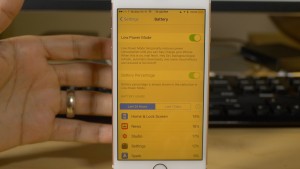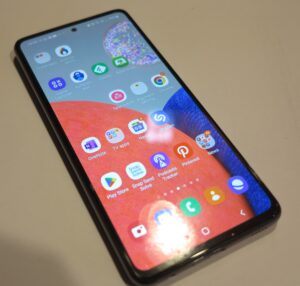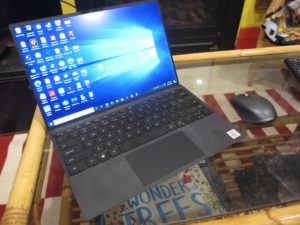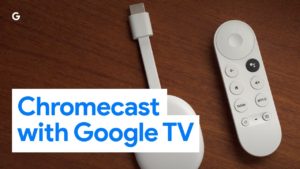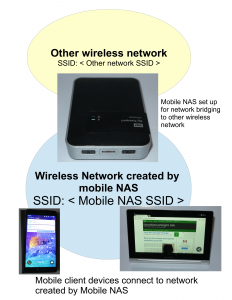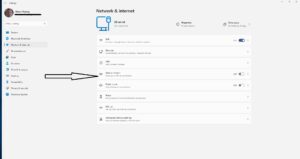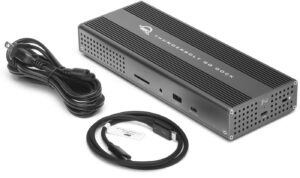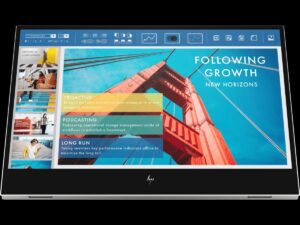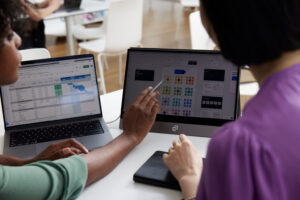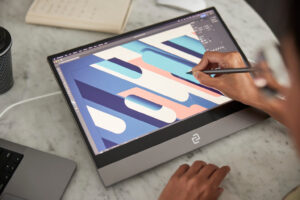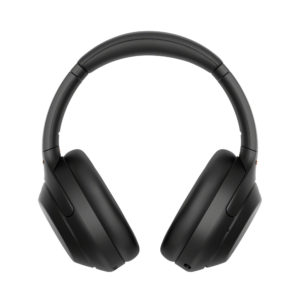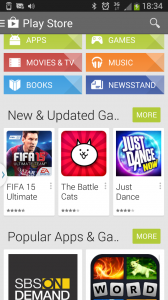
LG SoundPop 360 Bluetooth speakers
– an example of the popular Bluetooth speakers
A very popular accessory for smartphones, tablets and laptops is the Bluetooth speaker. These speakers connect to your mobile device via Bluetooth and work as an audio output device for it.
The typical design for most of these speakers is to be a highly portable battery-operated unit that can fill a small area with sound in a manner equivalent to the typical portable radio. These appear in many different sizes from something that fits in your palm to larger tube-shaped units that can be carried using a strap or shoved in your coat pocket. Add to this an increasing number of larger cube-shaped speakers that put out a bass rich sound.
Add to this larger mains-powered bookshelf active speakers that have Bluetooth audio functionality in them along with a variety of inputs like analogue line-level and phono inputs or USB, SP/DIF and HDMI digital-audio inputs. These are being pitched as a way to set up a stereo for an office or small apartment.
In a lot of cases especially with portable speakers, these have a built-in microphone so they can become a speakerphone for your mobile device, something that can come in handy for conference calling including Zoom calls. But some Bluetooth speakers like the B&O Beosound A1 2nd Generation speaker even have this function set up so they work with your smartphone or tablet as a voice-activated smart speaker.
T

Bang & Olufsen Beosound A1 2nd Generation Bluetooth smart speaker that works with a smartphone or similar devicce to benefit from Amazon Alexa
hese exist in a universe of Bluetooth audio endpoints like audio adaptors that work between a line-level audio connection and Bluetooth Classic audio as either a transmitter or receiver. This is in addition to home audio equipment receiving Bluetooth audio as an input and/or transmitting content available to it as a Bluetooth audio stream.
An example of this is in the form of portable and mantel radios that work as Bluetooth speakers. This device class has capitalised on the interest over the last 15 years in premium radios thanks to the likes of Bose and Tivoli offering radios that look and perform “above average”; the nostalgia for vintage-styled radios, along with broadcast radio being delivered via digital-broadcast technology or Internet technology and yielding programming exclusive to those technologies.
It includes companies offering audio source devices like turntables or CD players that stream to Bluetooth speakers. This is because the Bluetooth audio specifications are in fact “application-level” specifications that have been pre-determined for a long time, so there as surety that their source devices can work with any Bluetooth audio endpoint device. Here, it could allow someone to create an elementary sound system around that device and a pair of Bluetooth speakers.
Some of these speakers come with other features like LED-driven “party lights” or very large batteries that work as powerbanks for charging mobile devices. As well, a lot of larger portable Bluetooth speakers make use of passive radiators as a way to increase their bass response while others rely on an app-driven approach to allow you to adjust their sound quality from your smartphone.
Multi-speaker operation
But, thanks to Bluetooth 5, there has been an interest in multi-speaker Bluetooth audio approaches. This comes in the form of two operating modes:
Party Mode: Multiple speakers play the same programme content from the same source device with speakers that are stereo-designed playing the content in stereo across the speakers in that same box. This is to provide more sound coverage, typically for entertaining people at a party. Most such setups can handle a relatively large number of speakers due to latency not being considered important for this use case.
Stereo Mode: A pair of like speakers are set up so that one plays the left channel of a stereo programme source from one source device while the other plays the right channel of that same source. This is to improve the channel separation for the stereo content.
Typically manufacturers are limiting this functionality to a subset of their Bluetooth-speaker product range, more so the products in the “value” and “premium” market positionings.
These operating modes may work in one of two arrangements;
Source-to-speakers / hub-and-spoke: The source device streams the audio content to the speakers at once. This is typically implemented for stereo-mode operation so as to reduce latency by making sure the data gets to each speaker without any middleman device processing it.
Speaker-to-speaker / daisy-chain: The source device streams the audio content to one speaker which passes it on to other speakers down the line. This appeals to party-mode operation so as to permit large numbers of speakers to be in the setup. It may allow speakers to introduce some latency but this isn’t an issue for party-mode operation due to the goal of covering a large area with sound.
What to watch
Bluetooth LE Audio and its impact on Bluetooth speakers
Bluetooth LE Audio has been cemented in stone as the next-generation Bluetooth multimedia audio standard and is expected to provide a raft of improvements for this device class.
This implements the Bluetooth LC3 audio codec which is about efficient audio data transfer and even improve sound quality, operational stability and battery runtime. Here it also allows mobile-technology designers to avoid reinventing the wheel for audio-codec improvements when it comes to baseline audio performance for Bluetooth audio.
For portable Bluetooth speakers, this could be about allowing you to move around more freely with your mobile device without fear of losing the music as well as being able to run for a long time before needing to be charged up. As well, there will be the ability for these speakers and similar devices to cope with congested 2.4GHx wireless environments like in a city centre because of the robustness that the LC3 audio codec will offer.
This could impact how they are designed such as to have portable speakers that are lighter because of not needing to design around large battery packs. There will also be the chance to design higher-quality portable Bluetooth speakers that take advantage of higher quality sound that the new codec offers. Multi-speaker setups, especially based on Auracast, could be benefitting if the setup permits meshed or daisy-chained operation because of reduced latency in such setups and less impact on battery runtime for the actual sound reproduction.
Auracast broadcast audio will come in to its own with Bluetooth speakers that implement the Bluetooth LE Audio standard. Firstly, this could be about multiple-speaker party-mode operation without a requirement to use particular speakers from the same manufacturer. It may even allow the use of multichannel setups within the same Auracast multi-speaker setup rather than having “party mode” or “stereo mode” being mutually exclusive. Here, you would be using “audio sharing” on your phone, tablet or laptop to facilitate this mode with the device being enabled for Bluetooth LE Audio and Auracast.
As well, Auracast-based broadcast audio and Bluetooth speakers can be a perfect partner here. For example, a small Bluetooth speaker used in this context could be about close listening to an alternative soundtrack for video or other content or following an event going on in a nieghbouring area from another small room where you might be engaging in activity relating to that event.
Similarly, Auracast with Bluetooth speakers could be a logical follow-on to FM radio where listenership using BYO audio devices is desired for an event hosted in an area with a small footprint.
Previously, radio broadcasters were often collaborating with event organisers to broadcast the musical soundtrack to a large public event like a fireworks display, street parade or motorcade. Then you would have to bring a portable radio to that event and tune in to that station to follow the soundtrack using that radio to get the best value from that event. This approach may be seen as irrelevant for a radio station with a large broadcast area like a major city’s metropolitan area unless the event has a large footprint that takes in more of that broadcast area such as a fireworks display encompassing a waterway that passes through the city.
Similarly, there were the drive-in cinemas where you tuned your car radio to a particular frequency to hear the film’s soundtrack. Here, this was limited to what the FM band was about and issues like destructive multipath that could ruin your listening experience.
Here, Auracast could lead towards a license-free wireless audio distribution approach centred around Bluetooth speakers that implement Bluetooth LE Audio technology. It would also be about increased flexibility within the setup like multichannel speaker clusters (think stereo pairs or speakers plus subwoofer setups).
The Bluetooth LE Audio specification will also impact multiple-input operation for Bluetooth speakers. This could be about seamless multipoint operation when you want to use a speaker with a smartphone and laptop or allowing your party guests to contribute to the music at your party using their devices. It could also be about party speakers that work with Bluetooth LE Audio microphones for karaoke and PA usage.
How Bluetooth LE Audio will come in to play for devices like Bluetooth headsets and speakers is the availability of dual-mode system-on-chip circuitry for this class of device. This will allow devices to work in a Bluetooth LE Audio or Bluetooth Classic Audio mode depending on what Bluetooth device they are working with, so as to assure maximum compatibility.
What could be done
There could be an emphasis towards optimising for and promoting mesh operation within multiple-speaker setups. Here, it can be used to make these setups more robust including allowing you to position your smartphone or other source device near any of the member speakers to assure audio continuity.
Multi-speaker setups could also be about bass improvement such as to add a subwoofer in to a party-mode or stereo-mode setup to pump up the bass. This also includes use of speakers that implement separately-amplified bass drivers being capable of working as part of these setups, especially “stereo-mode” setups.
There could be less reliance on “app-cessory” operation for common advanced functionality like tone control or lighting control. This could be facilitated with application-level functionality in Bluetooth LE Audio for these functions and avoid the need to create buggy apps for mobile and desktop platforms.
Manufacturers could look towards offering a variant of their Bluetooth speaker designs that has a broadcast-band radio tuner built in. Here, if you had already bought a particular speaker and then know there is one of the same design as what you already bought but has the radio functionality as well, you could justify buying the one with the radio so you can have a pair of speakers for party-mode or stereo-mode operation. It could also incentivise the manufacturer to design the speakers to work in multi-speaker mode for radio broadcasts as well as your phone’s audio.
It could extend to Bluetooth speakers that have line-input connections being able to stream the device connected to that input across a multi-speaker setup. This would extend the utility of that connection for multi-channel setups or party-mode setups.
Other complementary standards could be worked on to bring more utility out of the Bluetooth speaker class. For example, the HDMI-ARC standard could be worked on in a manner to support delivery of multiple soundtracks for the same video content. Here, this could incentivise the development of soundbars and AV receivers that allow streaming of different soundtracks to Bluetooth audio endpoints associated with the same device. That could allow a viewer to hear an alternate-language or audio-described soundtrack for video content using a Bluetooth headset or speaker paired to the soundbar or AV receiver while others hear the main soundtrack for that same content through that soundbar.
What I see that will affect Bluetooth speakers is the next few model cycles is to have Bluetooth LE Audio support as a heavily-marketed feature that will improve how they operate in many ways. It is something that I would see drip through a manufacturer’s Bluetooth audio product range.

